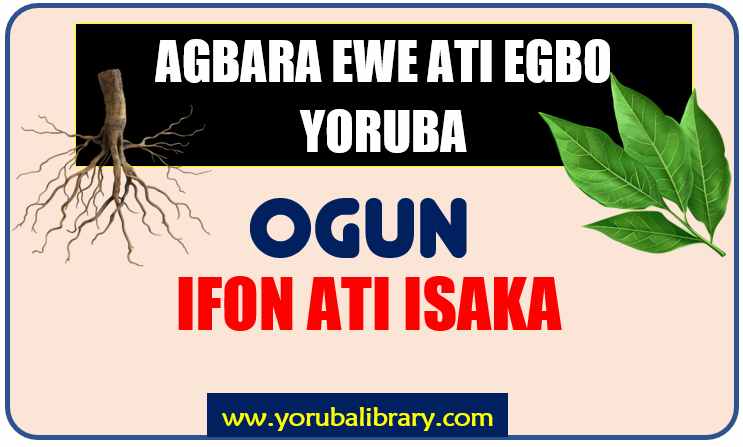
support@yorubalibrary.com
+2348073529208, 07038599574

Skin health is considered the overall physical well-being in Yoruba tradition. Conditions like eczema, pimples, or other rashes are not merely skin problems—they are often seen as signals of imbalance in the body and exposure to toxins. Ogun Ifon ati Isaka is a traditional Yoruba medicine designed to restore skin health, reduce inflammation, and harmonize the body. This medicine is a combination of carefully selected leaves, roots, and barks, prepared with utmost effectiveness to activate its healing properties. Elders believed that effective treatment requires physical cleansing.
This medicine is a combination of carefully selected leaves, roots, and barks, prepared with utmost effectiveness to activate its healing properties. Elders believed that effective treatment requires physical cleansing.
For different years ago, families have used Ogun Ifon ati Isaka to treat persistent skin problems, offering relief where modern medicine may not have been accessible.
Disclaimer
Yoruba Library and its Team will not be held liable for improper usage or any loss arising from improper use, wrong application, inability to find needed materials, or misinterpretation of this article. This article is provided strictly for guidance and educational purposes.
Symptoms of Skin Rashes
Yoruba forefathers observed signs when diagnosing skin conditions:
• Red, inflamed patches on the skin.
• Persistent pimples or eruptions.
• Dark spots or blemishes forming after scratches or infections.
• Irritability or discomfort due to itching and inflammation.
• Stress or anxiety aggravating the condition.
• Poor sleep or restlessness linked to skin irritation.
Elders used these signs to determine the appropriate preparation and dosage for Ogun Ifon ati Isaka, ensuring a treatment that strengthens both body and spirit.
How Our Forefathers Treated Ogun Ifon ati Isaka in the Past
• Trado-Medicine preparation applied directly to affected areas to reduce inflammation.
• Bathing in medicinal leaf mixtures to cleanse the skin and promote healing.
• Anointing with tress sap/latex to protect the skin from recurring rashes.
Find below some of the plants and roots that are known to be highly potent in treatment of Ifon ati Isaka ara
1) Ewe Laali
2) Ewe Odundun
3) Ewe Tanaposo
4) Ewe Ireke
5) Eso Iyeye
6) Egbo Igi Oruwo
7) Ewe Eepin
Have you heard of Yoruba Herb Dictionary? This contains names of Yoruba Leaf, Roots, Barks, Characteristics, Properties & Identification with HD Pictures. Order below or download sample here
A-Z HERBS & LEAF DICTIONARY #4KOne Yoruba proverb says "Bí olóde ò kú, òde rè kì í wu Gbégi". Do you know that Gbégi is actually a leaf/plant? Get Yoruba Proverbs on Plants and Herbs, which is a collection of Untold Wisdoms Hidden in Leaf and plants comprising their Life Applications & Moral Teachings. Order below or download sample here
YORUBA PROVERBS ON PLANTS #4KThe Healing Process in Traditional Practice
Elders followed careful steps to ensure maximum effectiveness:
• Collecting leaves, roots, or barks during times believed to increase potency.
• Cleaning, pounding, and boiling herbs into decoctions or pastes.
• Adding utterances (ofo) activations to enhance medicinal power.
• Applying first doses with careful observation.
• Combining topical and oral treatments with dietary and lifestyle guidance.
Differences Between Yoruba and Modern Skin Treatment
• Focus of healing —
Yoruba remedies emphasize holistic balance; modern medicine targets symptoms and uses pharmaceuticals.
• Materials used —
Yoruba healers use herbs, roots, and barks; modern treatments rely on creams, ointments, or antibiotics.
• Approach to recurrence —
Yoruba methods include spiritual protection and lifestyle adjustment; modern medicine may rely on continuous application of creams.
Safety First: Important Contraindications and Considerations
1) Pregnancy and Lactation — Some herbs may be too strong.
2) Underlying Conditions — Sensitive skin or allergies require caution.
3) Quality of Source — Avoid herbs from polluted areas.
Needed Materials (Leaves, Roots, Bark, etc.)
The medicinal approach for this requires careful selection of natural materials traditionally known to our elders. These are combined to ensure potency.
The instruction you will receive is the original account of our forefathers, preserved and tested over time. Many people have used them with testimonies of relief. Just ensure you follow the correct guidelines. Click Unlock Secret below
Application Process
The strength of Yoruba medicine depends on how materials are handled. Proper pounding, boiling, or steeping — done in the right way and at the right time — ensures the remedy remains potent. Click Unlock Secret below
Uses
The prepared remedy must be applied in the correct manner — whether for drinking, steaming, bathing, or chest rubbing — and taken in the right dosage for it to remain effective.
1) Some leaf required special utterances/chants before they can be effective. Where applicable, this will be stated in the PDF
2) The methods of getting the needed items like leaf, bark, roots by yourself is covered in the PDF
3) Saa bi Ologun ti wi, ki o le baa je... (Follow instructions for it to remain potent). You're getting a Real and Original account of our fore fathers.
With Numerous Satisfied Clients...